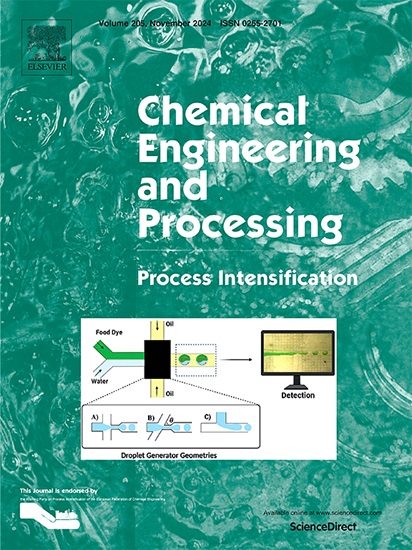采用人工神经网络模拟的方法,对搅拌结构填料萃取塔的效率进行了实地考察
IF 3.8
3区 工程技术
Q3 ENERGY & FUELS
Chemical Engineering and Processing - Process Intensification
Pub Date : 2025-04-10
DOI:10.1016/j.cep.2025.110318
引用次数: 0
摘要
液液萃取(LLX)是各行业分离工艺的基本应用。萃取柱是LLX操作中必不可少的设备。设计和扩大提取柱需要对流体动力学参数和传质性能有全面的了解。因此,本研究对Scheibel柱的传质特性进行了研究。共收集42个实验数据点,探讨操作条件对整体传质系数的影响。结果表明,转子转速(N)对Kod的影响显著,而连续相和分散相的流量对Kod的影响较小。随后,利用先前的模型确定了Kod,但没有一个模型能准确预测Kod。因此,提出了一种新的相关性来估计Kod作为Reynolds (Re)和Weber (We)数以及分散相持率(xd)的函数。这种新的相关性证明了与实验数据的良好一致性,使其成为设计谢贝尔提取柱的有价值的工具。最后,以转子转速(N)、连续相速度(Vc)、分散相速度(Vd)和扩散系数(Dd)为输入参数,应用4种不同的人工神经网络模型对Kod进行预测。MLPNN、RBFNN和CFFNN模型对Kod的预测是准确可靠的。本文章由计算机程序翻译,如有差异,请以英文原文为准。

Examining the efficiency of the stirred structure packed extraction column with hands-on investigation using simulation incorporating artificial neural networks
Liquid-liquid extraction (LLX) is a fundamental application of separation processes utilized in various industries. Extraction columns are essential equipment in LLX operations. Designing and scaling up extraction columns necessitates a comprehensive understanding of hydrodynamic parameters and mass transfer performance. Therefore, this study investigates the mass transfer characteristics of Scheibel column. A total of 42 experimental data points were collected to explore the impact of operating conditions on the overall mass transfer coefficient. The results indicated that rotor speed (N) significantly affects Kod, while the flowrates of the continuous and dispersed phases have a minimal impact. Subsequently, Kod was determined using previous models, but none of them accurately predicted Kod. As a result, a new correlation was proposed to estimate Kod as function of the Reynolds (Re) and Weber (We) numbers, and the holdup of dispersed phase (xd). This new correlation demonstrated excellent agreement with experimental data, making it a valuable tool for designing Scheibel extraction columns. Lastly, four different ANN models were applied to forecast Kod using rotor speed (N), continuous phase velocity (Vc), dispersed phase velocity (Vd), and diffusion coefficient (Dd) as input parameters. MLPNN, RBFNN, and CFFNN models proved to be accurate and reliable in predicting Kod.
求助全文
通过发布文献求助,成功后即可免费获取论文全文。
去求助
来源期刊
CiteScore
7.80
自引率
9.30%
发文量
408
审稿时长
49 days
期刊介绍:
Chemical Engineering and Processing: Process Intensification is intended for practicing researchers in industry and academia, working in the field of Process Engineering and related to the subject of Process Intensification.Articles published in the Journal demonstrate how novel discoveries, developments and theories in the field of Process Engineering and in particular Process Intensification may be used for analysis and design of innovative equipment and processing methods with substantially improved sustainability, efficiency and environmental performance.

 求助内容:
求助内容: 应助结果提醒方式:
应助结果提醒方式:


